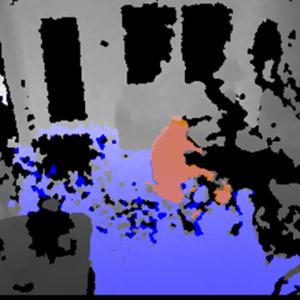Sensor systems identify senior citizens at risk of falling within 3 weeks

A sensor system developed and used by researchers at the University of Missouri produces images and sends automatic email alerts that can be used to predict a fall within a three-week period. Photo courtesy of MU Center for Eldercare and Rehabilitation Technology
“We have developed a non-wearable sensor system that can measure walking patterns in the home, including gait speed and stride length,” said Marjorie Skubic, director of the MU Center for Eldercare and Rehabilitation Technology and professor of electrical and computer engineering. “Assessment of these functions through the use of sensor technology is improving coordinated health care for older adults”
To predict falls, researchers used data collected from sensor systems at TigerPlace, an innovative aging-in-place retirement residence, located in Columbia, Mo. The system generated images and an alert email for nurses indicating when irregular motion was detected. This information could be used to assist nurses in assessing functional decline, providing treatment and preventing falls.
“Aging should not mean that an adult suddenly loses his or her independence,” said Marilyn Rantz, Curators' Professor Emerita of Nursing. “However, for many older adults the risk of falling impacts how long seniors can remain independent. Being able to predict that a person is at risk of falling will allow caretakers to intervene with the necessary care to help seniors remain independent as long as possible.”
Results from an analysis of the sensor system data found that a gait speed decline of 5 centimeters per second was associated with an 86.3 percent probability of falling within the following three weeks. Researchers also found that shortened stride length was associated with a 50.6 percent probability of falling within the next three weeks.
Additional research led by Rantz and Skubic recently received an award from Mather LifeWays ® Institute on Aging. Their research has found that by integrating care coordination and sensor technology at TigerPlace, residents are able to live independently on average of four years compared to the national average of 22 months.
“Using embedded sensors in independent living to predict gait changes and falls,” recently was published in the Western Journal of Nursing Research. Future research on the sensor systems will focus on how nurses can best use the fall prediction statistics to intervene before the fall occurs. Contributing to the study were MU researchers Lorraine Phillips, Chelsea DeRoche, Gregory Alexander, Laurel Despins, Carmen Abbott, Bradford Harris, Colleen Galambos and Richelle Koopman. Research was supported by the National Institutes of Health (RO1NR014255). The content is solely the responsibility of the authors and does not necessarily represent the official views of the funding agency.
Media Contact
All latest news from the category: Medical Engineering
The development of medical equipment, products and technical procedures is characterized by high research and development costs in a variety of fields related to the study of human medicine.
innovations-report provides informative and stimulating reports and articles on topics ranging from imaging processes, cell and tissue techniques, optical techniques, implants, orthopedic aids, clinical and medical office equipment, dialysis systems and x-ray/radiation monitoring devices to endoscopy, ultrasound, surgical techniques, and dental materials.
Newest articles

NASA: Mystery of life’s handedness deepens
The mystery of why life uses molecules with specific orientations has deepened with a NASA-funded discovery that RNA — a key molecule thought to have potentially held the instructions for…

What are the effects of historic lithium mining on water quality?
Study reveals low levels of common contaminants but high levels of other elements in waters associated with an abandoned lithium mine. Lithium ore and mining waste from a historic lithium…

Quantum-inspired design boosts efficiency of heat-to-electricity conversion
Rice engineers take unconventional route to improving thermophotovoltaic systems. Researchers at Rice University have found a new way to improve a key element of thermophotovoltaic (TPV) systems, which convert heat…



